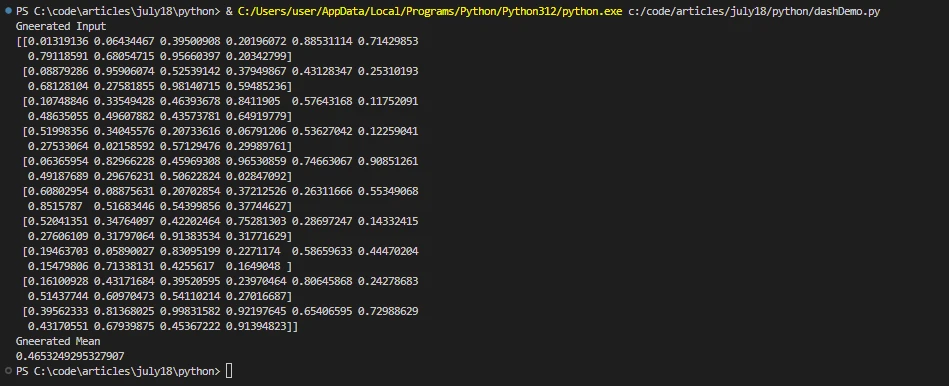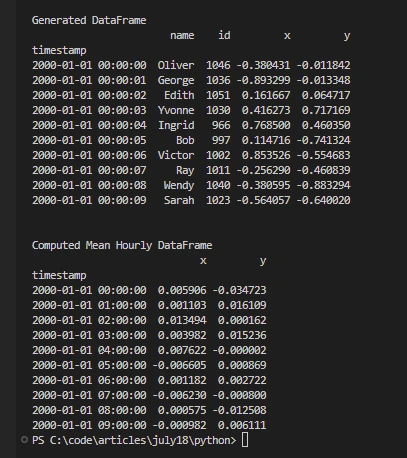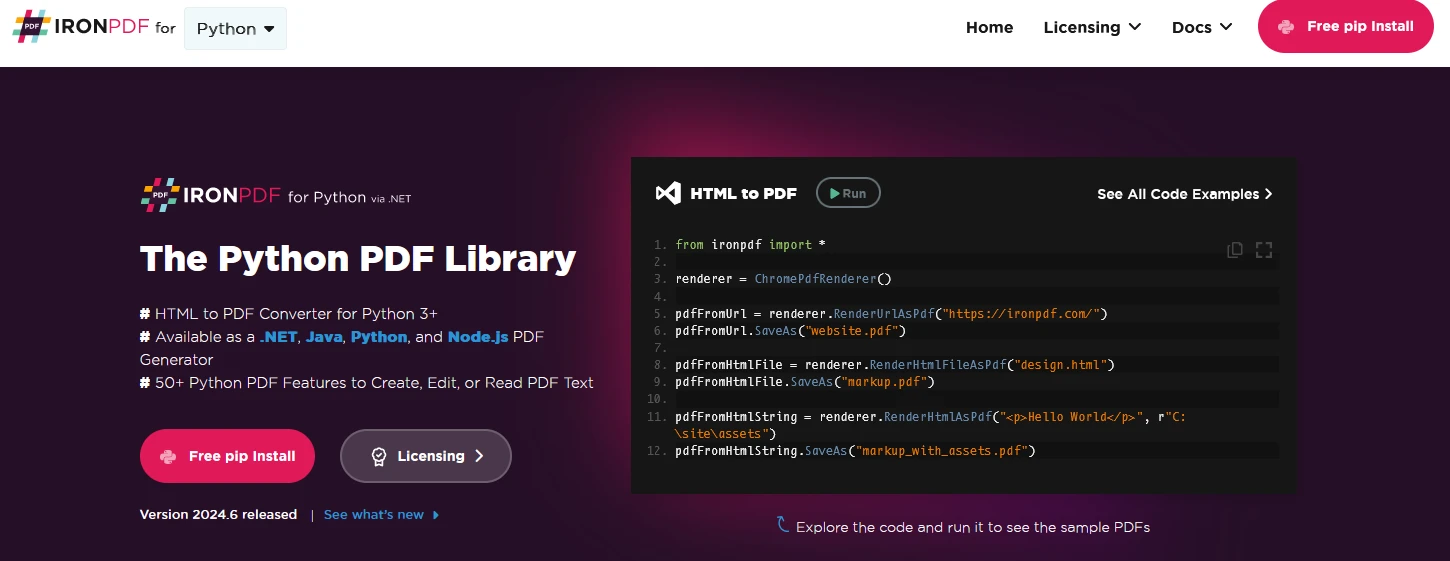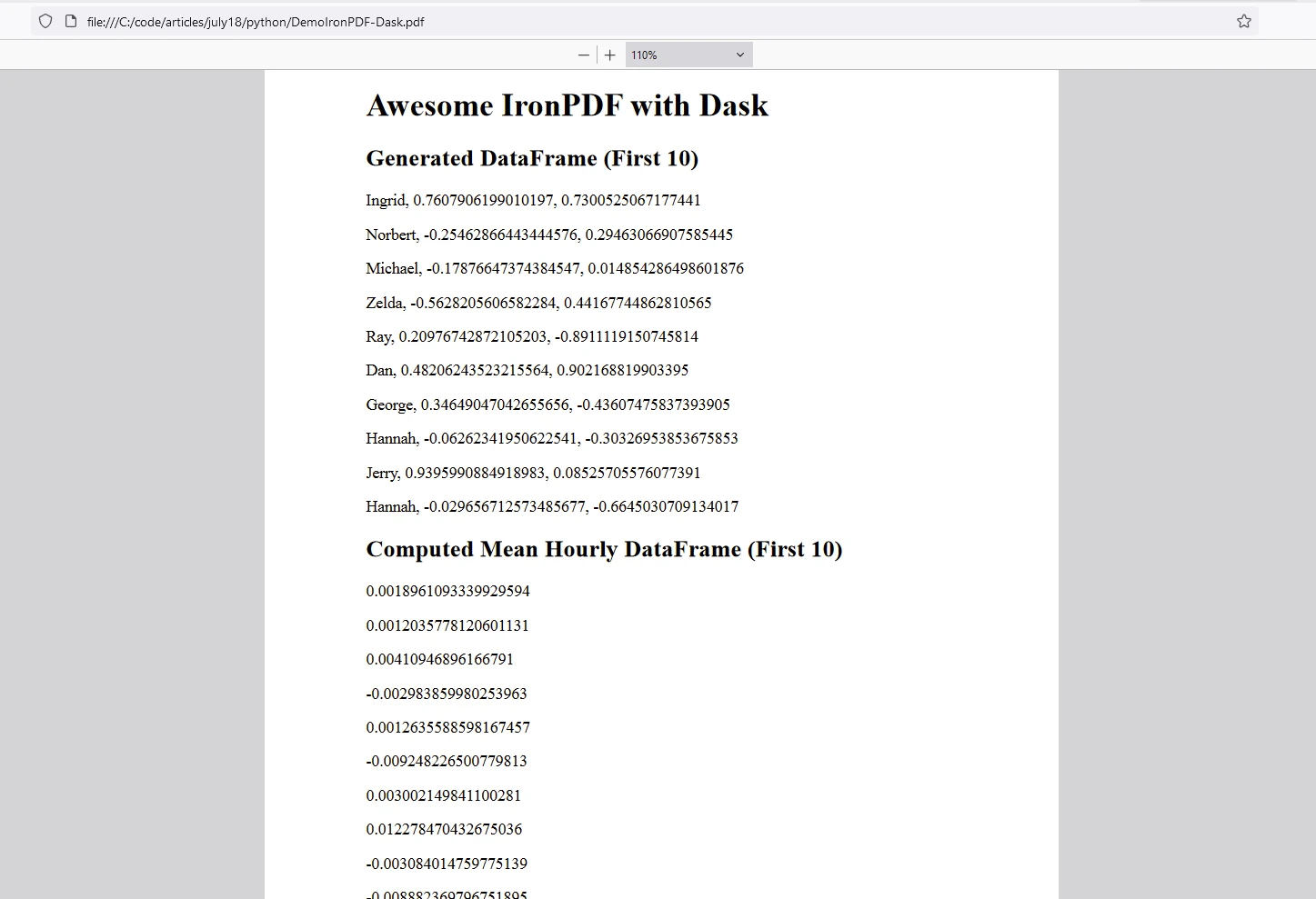Test in production without watermarks.
Works wherever you need it to.
Get 30 days of fully functional product.
Have it up and running in minutes.
Full access to our support engineering team during your product trial
Python is a powerful language for data analysis and machine learning, but handling large datasets can be challenging for data analytics. This is where Dask**** comes in. Dask is an open-source library that provides advanced parallelization for analytics, enabling efficient computation on large datasets that exceed the memory capacity of a single machine. In this article, we will look into the basic usage of the Dask library and another very interesting PDF-generation library called IronPDF from Iron Software to generate PDF documents.
Daskis designed to scale your Python code from a single laptop to a large cluster. It integrates seamlessly with popular Python libraries like NumPy, pandas, and scikit-learn, to enable parallel execution without significant code changes.
You can install Dask using pip:
pip install dask[complete]Here’s a simple example to demonstrate how Dask can parallelize computations:
import dask.array as da
# Create a large Dask array
x = da.random.random((10, 10), chunks=(10, 10))
print('Gneerated Input')
print(x.compute())
# Perform a computation
result = x.mean().compute()
print('Gneerated Mean')
print(result)In this example, Dask creates a large array and divides it into smaller chunks. The compute() method triggers the parallel computation and returns the result. The task graph is used internally to achieve parallel computing in Python Dask.

Dask DataFrames are similar to pandas DataFrames but are designed to handle larger-than-memory datasets. Here’s an example:
import dask
df = dask.datasets.timeseries()
print('\n\nGenerated DataFrame')
print(df.head(10))
print('\n\nComputed Mean Hourly DataFrame')
print(df[["x", "y"]].resample("1h").mean().head(10))The code showcases Dask's ability to handle timeseries data, generate synthetic datasets, and compute aggregations like hourly means efficiently, leveraging its parallel processing capabilities. Multiple Python processes, distributed scheduler and multiple cores computational resources are used to achieve the parallel computing in Python Dask DataFrames.


IronPDF is a robust Python library designed for creating, editing, and signing PDF documents using HTML, CSS, images, and JavaScript. It emphasizes performance efficiency with minimal memory usage. Key features include:
pip install ironpdf
pip install daskTo start with, let us create a python file to add our scripts
Open Visual Studio Code and create a file, daskDemo.py.
Install necessary libraries:
pip install dask
pip install ironpdfThen add the below python code to demonstrate the usage of IronPDF and Dask python packages
import dask
from ironpdf import *
# Apply your license key
License.LicenseKey = "key"
df = dask.datasets.timeseries()
print('\n\nGenerated DataFrame')
print(df.head(10))
print('\n\nComputed Mean Hourly DataFrame')
dfmean = df[["x", "y"]].resample("1h").mean().head(10)
print(dfmean)
renderer = ChromePdfRenderer()
# Create a PDF from a HTML string using Python
content = "<h1>Awesome Iron PDF with Dask</h1>"
content += "<h2>Generated DataFrame (First 10)</h2>"
rows = df.head(10)
for i in range(10):
row = df.head(10).iloc[i]
content += f"<p>{str(row[0])}, {str(row[2])}, {str(row[3])}</p>"
content += "<h2>Computed Mean Hourly DataFrame (First 10)</h2>"
for i in range(10):
row = dfmean.head(10).iloc[i]
content += f"<p>{str(row[0])}</p>"
pdf = renderer.RenderHtmlAsPdf(content)
# Export to a file or Stream
pdf.SaveAs("DemoIronPDF-Dask.pdf")This code snippet integrates Dask for data handling and IronPDF for PDF generation. It demonstrates:
Renders this HTML content into a PDF (`pdf`) using `ChromePdfRenderer()`.
Saves the PDF as "DemoIronPDF-Dask.pdf".
This code combines Dask's capabilities for large-scale data manipulation and IronPDF's functionality for converting HTML content into a PDF document.


IronPDF license key to allow users to check out its extensive features before purchase.
Place the License Key at the start of the script before using IronPDF package:
from ironpdf import *
# Apply your license key
License.LicenseKey = "key"Dask is a versatile tool that can significantly enhance your data processing capabilities in Python. By enabling parallel and distributed computing, it allows you to work with large datasets efficiently and integrate seamlessly with your existing Python ecosystem. IronPDF is a powerful Python library for creating and manipulating PDF documents using HTML, CSS, images, and JavaScript. It offers features such as HTML-to-PDF conversion, PDF editing, digital signing, and cross-platform support, making it suitable for various document generation and management tasks in Python applications.
Together with both the libraries, the data scientists can perform advance data analytics and data science operations. Then store the output results in standard PDF format using IronPDF.